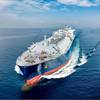IZAR’s Puerto Real Shipyard recently christened the LNG carrier Cadiz Knutsen, with representatives of the owners Knutsen OAS and Marpetrol and the final client, Unión Fenosa Gas. This ship will transport up to 138,000 cu. m. of gas at –163ºC, and is the fourth LNG carrier built at IZAR, and the second one of those built at Puerto Real facilities. There is a third unit under construction at this shipyard for the shipowner Fernandez Tapias. The vessel will transport gas from the Damieetta port liquefaction plant in Egypt to the gasification terminals in Ferrol and Sagunto. It will take 15 days and 10 days respectively for the ship to cover the routes at design speed, 19.5 knots.
Izar has three similar LNG carriers, two from the Sestao Shipyard and one more at the Puerto Real yard
Cadiz Knutsen has a time charter contract signed in the year 2000 between Unión Fenosa Gas and the owners Marpetrol from Spain. Knutsen will operate the LNG carrier by bareboat charter.
The LNGs built by Izar conform to all existing regulations, including double hull, double bottom in the cargo area, and the four cryogenic cargo tanks with GTT Membrane Type No. 96 E2, where the natural gas is transported at atmospheric pressure and at a temperature of –163º C. This membranes, directly attached to the ship’s double hull/double deck, etc., have two missions: To reduce the transfer of heat to the atmosphere and the cargo tanks to minimize the evaporation of liquefied natural gas and thermally insulating the structural steel and transmitting the cargo’s weight to the steel structure.
Each of the 0.7 mm thick and 500 mm large membranes, made of Invar sheets (metal alloy with a 36% content of nickel), counts with an insulating barrier of two layers of perlite (aluminium oxide of granular shape with silicon)-filled plywood casings to prevent water and humidity. Each LNG carrier counts with 52,000 cases.
Another feature of these LNG carriers is the utilization of the vaporized gas that is burned up inside the boilers to feed the steam turbine, which is able to generate up to 28,000kW at 83rpm. The maximum level of vaporisation of the cargo is less than 0.15% of the tanks’ total volume.
Propulsion
The main turbine is a Kawasaki Izar type that generates a maximum continuous of 20,000 kkW at 83 rpm. Izar’s Turbines factory has also provided the condenser of the propulsion plant.
Steam is generated by two water tube boilers with dual fuel burning system (heavy F-O. Or boil-off gas or LNG or dual fuel) of equal size and fitted with superheaters, air heaters and automatic combustion controls. They produce 65t with 61,9kg/cm2 and 515 ºC.
A single shaftline and five blades fixed-pitch propeller with an 8600 mm diameter complete the propulsion package.
The electricity –generating plant comprises two turbine-alternator sets of an output of 3510 kW at 1500 rpm, a Diesel generator powered by a 3510kWengine and a 550kW emergency diesel generator.
Izar Manises, the two stroke diesel engines factory, provided 5 deck cranes. Two are of the GPH500-1227 model and operate tubes that elevate 12t at 26.5 m. Two are service ones of the GPS 320-1218 type, able to lift 12 t at 17m. Finally the fifth one is a service one of the GPS 40-0210 type capable to raise 2.1t at 10m and 4.5 t at 5.7m.
Featured videos

Inmarsat Enhances Service to Drive Digitalization

Inside the Electrified Truckable Tug

Tracking Foreign Vessels Working in the U.S. Jones Act Market
Subscribe for
Maritime Reporter E-News
Maritime Reporter E-News is the maritime industry's largest circulation and most authoritative ENews Service, delivered to your Email five times per week









